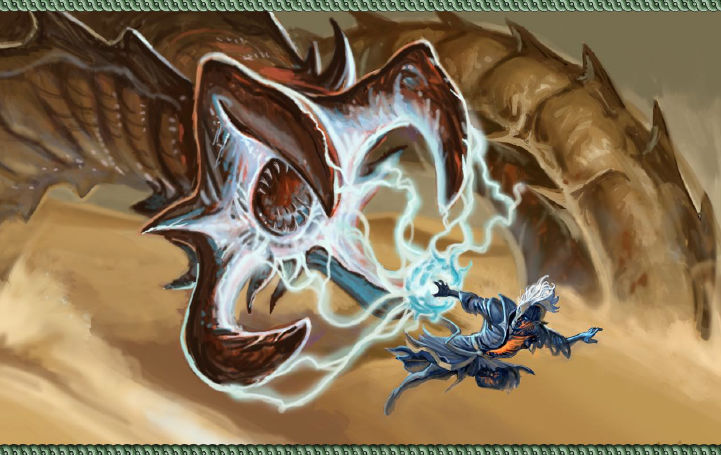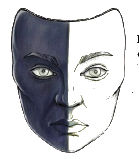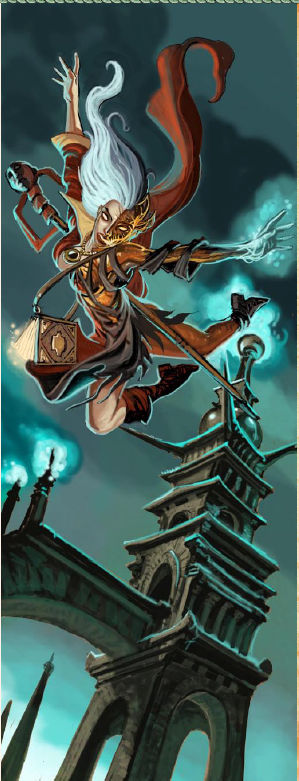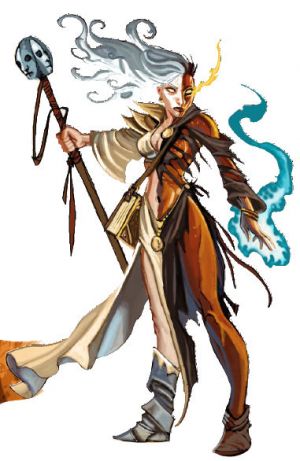Néthys

- “Magic is all things, and in all things. It is in the air, the stone, the flame, the water. It is time, space, and the void. It will nurture you, it will consume you, and always will it be your master.”
- —The Book of Magic
Introduction[1]
Nethys (neth-uhs) is said to have once been a god-king of osirion, Obsessed with magical knowledge. When his studies allowed him to perceive all that transpired, even on other planes, this omniscience fueled his transformation into a deity, but at the cost of his psyche. Now his fractured mind seeks to destroy the world and to heal it, to bend and to preserve it, to conquer and to free it. As such, he represents the most benign spells and the most vile necromancy, and mortal spellcasters of all alignments ask for his blessing.
Préférence[1]

Nethys’s only concern is magic—its use, creation, and innovation. He is aware of his mortal worshipers and rewards their devotion with divine power, but not just for their use or abuse ofmagic. When some mortal tyrant outlaws the use of magic, Nethys expects his followers to intervene, though he issues no call to crusade. Alternatively, if a magocracy were to exile all commoners with no magical talent, he does not consider this a cheapening of magical knowledge or power. His total awareness means he sees every success and every failure, from the first cantrip learned by a fledgling hedge wizard to the rudiments of star-exploding magic being developed on the farthest-flung planet.
Other gods may lead their churches like parental figures, but Nethys acts more like the volatile but disinterested guardian of an estate, unconcerned about individual heirs as long as the vast legacy of the family continues Queries via commune and similar spells always give accurate information, but the tone may be amused, belligerent, cold, disappointed, enraged, and so on. Nethys’s extreme mood swings are a symptom of his ultimate knowledge and the price of his power.
Other deities have tried to stabilize or cure him, with and sometimes without his permission, but he inevitably perceives any progress as a depletion ofhis energy and reacts as if he is being attacked, negating their efforts. His allies have learned to tolerate his ever-changing nature, keeping him at a respectful arm’s length for the sake ofhis knowledge.
Nethys is the master of all magic: helpful, harmful, creative, destructive, arcane, divine, conventional, alchemical, and everything in between. He is a proponent of magic for all purposes, even frivolous or wasteful ones. Magic is an infinite resource that permeates all dimensions, and thus he insists there is no need to limit its use for fear of its eventual depletion. He sees magic-drained places like the Mana Wastes as aberrations, tumors in the world that can be excised, though dealing with them is not a high-priority concern unless they begin to grow and threaten the healthy flow ofmagic elsewhere. He is not adverse to technology unless it interferes with or supplants magic; indeed, he relishes the blending of technology and magic much as a chef enjoys mixing new foods into favorite dishes.

He embraces all who practice magic, regardless of the nature of that magic, how they practice it, what they do with it, or how good they are at it. He rejects those without the talent or discipline to learn it; a lowly rogue who knows a single cantrip is more valuable to him than the mightiest magic-less fighter. He doesn’t dispute the martial prowess or physical strength of those without magic, but they are as useless to him as a sailing ship is to a man living in a mountain cave. Other than this devotion to knowledge and magic and rejection of non-magic, Nethys is indifferent. Pleas for mercy or justice, incitements to violence, and invocations of fairness or the balance of power have no effect on him; he will act in the interest of increasing magical knowledge or according to his whim, but is otherwise unpredictable and unreliable. Nethys’s avatar is terrible to behold: a male human crackling with power, one side burned or even skeletal, the other flush with power and bleeding energy into the air. Nethys is often shown in his dual aspect; one side of him is burned and broken, unleashing terrible magic upon the world, while the other half is calm and serene, using magic to heal the sick and protect the innocent. Some depictions downplay this schism, showing him whole and focused, or put the undesired aspect in shadow, obscured by other creatures or extending beyond the border of the artwork, so only the preferred aspect is visible. Though most art depicts him as Garundi, some regional temples deviate from this by showing him as a member of a prominent local race, or even as an Azlanti.
Nethys is not known for showing favor or wrath to his followers or enemies in the form of divine intervention, a fact that many ofhis worshipers note with some pride. Though this self-important attitude does not endear them to members of other churches, it does reinforce the idea that Nethys doesn’t care what they do with their magic as long as they are using it. Layfolk, especially peasants, believe that invoking his name may help to ward off curses, hexes, the evil eye, and other superstitions, though his utter disregard for those who do not practice magic means these invocations fall on deaf ears. The devout believe that manifestations of zones of unpredictable magic are the result of Nethys passing close to the Material Plane—though there is no confirmation of this from the god himself. Likewise, his church teaches that the manifestation of zones of “empty magic” (where magic simply doesn’t function) are indications ofhis anger at someone or something in that area, though there is no evidence that this is true.
Formal ceremonies in the church require an elaborate robe, skullcap, mozzetta, and hood, all in similar colors (such as red, maroon, and burgundy); the particular color range is chosen by each temple. A two-colored face may be included as an insignia, or the mozzetta itself may be dark on one side and light on the other. Because most priests focus their energies and interests on knowledge rather than fashion, many “ceremonial” robes are worn in other circumstances; an adventuring wizard or cleric’s battle robe may be the very same one she wears to the highest religious function, honoring the god by wearing a potent magic item. Skullcaps and hoods are popular among the faithful. Many priests tattoo their faces and hands on one side to match their god’s image; darker-skinned priests rub white ash or other irritants into their fresh tattoos or cuts to create white scars.
Nethys is neutral and his portfolio is magic. His weapon is the staff, usually represented as a magical artifact rather than a mundane weapon. His holy symbol is his face, half black and half white, which may be very detailed or abstracted to little more than a two-colored shield-shape with eyes. His domains are Destruction, Knowledge, Magic, Protection, and Rune. His clergy is nearly equally divided between arcane and divine spellcasters; almost all of the divine casters are clerics, and over two-thirds of the arcane casters are wizards.
A typical worshiper of Nethys is one who seeks magical knowledge or power, whether as a sorcerer, a wizard, an alchemist, or a mere scholar. Most couldn’t care less about politics, and are only interested in what power they can amass, whether that leads to riches or merely more power. Some are generous and willing to teach what they know, but many are the stereotypically jealous and paranoid practitioners who seclude themselves and guard their scraps ofknowledge from all potential rivals.
Worship services vary from temple to temple, but usually include a weekly ceremony requiring chanting and spellcasting demonstrations. In many cases, the hymns are phonetic transcriptions ofverbal components of spells favored by that temple, allowing the faithful to chant a representation ofthe words ofpower. Musical instruments are rarely part of services unless the temple has a bardic priest, though limited percussion involving the tapping of wands or stamping of staves is not unusual.
Temples and Shrines[1]
Overall, the church of Nethys tries to balance the god’s two aspects, but individual temples often focus on one particular kind of magic and draw worshipers interested in that type. Opposing temples might war on each other, but Nethys doesn’t care, just as he doesn’t care if a good temple siphons magic from evil items, locks them away, or converts them to a more benign use. A few temples alternate between the god’s aspects or directly oppose the actions of other temples to keep the balance. Specialized temples are usually named in an identifying way so visitors are fully aware of their natures. For example, a Numerian temple devoted to deciphering the magical properties of starmetals may be called the Church of Skysteel, while a Gebbite temple studying necromancy may be called the Bone Cathedral.
Temples are often decorated in the same colors as those ofthe priests’ preferred ceremonial raiments, though they may just as easily be whitewashed, painted black, or left unmodified—aesthetics are secondary to the pursuit of magic. Any significant temple has at least one chamber set aside for the specific magic its inhabitants favor, such as a summoning circle for a temple of conjuration, an infirmary for a temple of healing, and so on; sometimes the true nature of a temple is a secret kept from the public, and this special chamber is hidden away so that no outsiders see it.
Once a year, the church demands of its priests a tithe of a minor magic item—such as a scroll or potion—that the temple can use or sell. Other priests (in hierarchal order) have the option to purchase these before layfolk or the public know about them; the temples do not want to become marketplaces sullied by the feet of the unworthy pecking at scraps of power discarded by the chosen elite.
A Priest’s Role[1]

Any wielder of magic may become a priest of the church, whether she be a standard practitioner of spells or something more primitive or exotic like a hedge wizard, witch doctor, adept, or folk ritualist. Even an alchemist, paladin, or ranger could become a priest, though most of these folk follow other gods and their actual magic is internalized or very specialized. However, advancement in the clergy is based on power and magical knowledge, which means most practitioners of simpler magic can only aspire to low ranks in the church. Priests associated with Nethys’s temples are used to magical folk being in charge, and often make the mistake of barking orders in more egalitarian groups such as adventuring parties; independent priests are less likely to do this, though most do consider themselves superior to nonmagical folk.
Those without magic may work for the church, but are treated as second-class citizens (or even as expendable in the more evil temples); even a lowly apprentice who has only mastered a few cantrips has higher status in a temple than a master rogue or talented fighter. Most senior temple guards have at least one level in a magical class or have acquired (via a feat or special ritual) the ability to cast a few spells in order to gain some respect in the eyes ofthe priests and establish a firm seniority over the common guards. Even the newest recruits are trained in Spellcraft so they recognize and do not needlessly fear magic.
Priests tend to be very mercenary in their services. They craft and sell magical goods, advise nobles and merchants on how magic can improve their stations, hire themselves as bodyguards for ships or caravans, or act as battle-casters for armies or adventuring companies. Some tithe service to a lord in exchange for property and a staff ofpeasants so they can focus on research. Others use their magic to entertain or swindle others. The only unifying feature of the followers ofNethys is an absolute love of magic. Some love the act of using magic, just as a master blacksmith loves shaping steel or a hedonist loves the act of sex. Others appreciate it as a tool of the highest quality, or even merely for the raw power it affords. The idea of conserving magic is ridiculous to them, and a member of the faith who refuses to use magic at an opportune time is considered suspect, if not cursed— much like the old adage of “never trust a skinny chef.”
Rank in the church is based on magical knowledge and power, with the former more important in benign temples and the latter more valued in malevolent ones. As masters of magic, priests are fully aware ofthe natural ranking of spell levels and caster levels and use this knowledge to quickly assess where someone fits in the pecking order. Individuals of a certain rank usually have one or more apprentices who have no status in the church until their master declares them sufficiently trained. Many young mages and clerics are recently graduated apprentices— or those whose masters died or cast them out for disobedience—hoping to use their meager knowledge to practice and learn more magic.
Priests have a limited role in most rural communities; unless the priests’ focus is animals, crops, or healing, they have little reason to interact with common folk. Urban priests have stronger ties to locals, particularly those connected to construction, trade, and the exotic interests of nobles; even a small temple can support itself comfortably on such business. Temple priests always have ranks in Knowledge (arcana) and Spellcraft, and depending on the temple’s focus, they may also have ranks in Appraise, Heal, Intimidate, and Use Magic Device. Temple priests are addressed as “disciple, “priest,” “brother,” or “sister,” depending on the speaker’s familiarity with the priest (and the priest’s gender). The head of a temple is usually just called “high priest,” though individual temples may use unique titles. Members of the faith who are not associated with a temple are usually called “acolyte,” “disciple,” or “master” depending on their apparent skill with magic; while it is not considered an insult to address a stranger by a lower-than-actual rank if the stranger isn’t dressed according to his or her actual rank, persisting in this error after a correction is made is considered very rude, or could even be taken as a challenge.
Holy Text[1]
The official text of the church is The Book of Magic, a comprehensive guide for channeling magic and discussing the moral ramifications ofits use and misuse (often taking opposing positions in the space of a few paragraphs). The information within the book is detailed enough that someone with the proclivity for wizardry can, after reading it cover to cover, eventually come to understand the basics of a few cantrips; more than one great wizard has started out by reading a stolen copy ofthis book and using it as the foundation for decades of study and innovation.
Aphorisms[1]
Given that Nethys knows more about magic than any being in the Outer Sphere, most of the aphorisms among his faithful refer to intimate knowledge of these studies and make little sense without similar understanding. A few even rely on word-play through phonetic pronunciations of certain magical runes that take on additional meaning in key languages. Two examples of this are as follows.
The Cube is the Red is the Sphere: This phrase requires an advanced level ofmagical knowledge to fully understand, and refers to an intellectual test between three wizards in which one realizes the answer to a puzzle because the other two have not answered it. In casual use among the faithful, this phrase refers to finding an answer to a problem based on the failures of others, as well as transforming something worthless into something useful or valuable.
Point with the Finger of the Scorched Black Hand: While technically this refers to a somatic component of many spells, it is a reference to the will of Nethys (whose right hand is blasted with raw magic) indicating the path to learning. In the Draconic tongue, the words for “point with the finger” sound similar both to a related phrase (“seek the greater knowledge”) and (depending on the syllables stressed) to a vulgar suggestion. Members of the faith sometimes use this as a written catchphrase to indicate their divine allegiance. Apprentices snicker about it once they understand the colloquial Draconic translation.
Holidays[1]
The month of Neth is named for the All-Seeing Eye. The church has three common holidays shared by all temples.
Abjurant Day: Occurring on 8 Neth, this is a day of working together to shore up mutual defenses and training friends and children in defensive magic. Benevolent casters traditionally use this day to test possible apprentices; evil casters do so as well, often by kidnapping prospective students and performing deadly tests to determine their readiness—or to eliminate potential rivals.
Evoking Day: 18 Neth is a day of magical fireworks displays, dueling (both mock and actual), and trading spells. In lands where Garundi people live, even commoners celebrate helpful magic by dancing with bright streamers and wearing black and white flowing robes (often designed to rise at the waist when the wearer spins).
Transmutatum: The 28th of Neth is a day of reflection and self-improvement. Some traditionalists believe it is fortuitous to begin researching spells or crafting difficult magic items on this day.
Relations with Other Religions[1]
Although Nethys’s madness makes it hard to keep him active in long-term plans, many deities rely upon his aid from time to time. In this way he is much like his martial counterpart, Gorum—indifferent to the ethics of an engagement and only concerned with his role and the use of his abilities. Despite his shattered mind, he is able to negotiate with other beings of similar power, and he does not unexpectedly turn on visitors or allies unless his omniscient senses reveal he is being threatened or doublecrossed. Because Nethys supports the use of any magic, he might ally with anyone in the pantheon, supplying spells, magic items, or even raw magical power. Of course, he knows better than to lend aid to agents of Rovagug if that assistance could free the Rough Beast, and is careful to limit these exchanges to minor spells and items; despite his destructive aspect, he does not wish the entire world ruined. Though other deities may assume his disdain for anything but knowledge and magic would make him ignore Gorum entirely, the Lord in Iron appreciates battle magic, and the two have a mutual appreciation for power and strategy. Irori is of special interest to Nethys because they are both ascended mortals, neither of whom used the Starstone “shortcut,” and because Irori’s perfection of his physical self transcends the divide between the extraordinary and supernatural; Nethys paradoxically wants to praise Irori for his achievement and tear him apart to figure out how he did it.
New Spell[1]
Sorcerers and wizards who worship the All-Seeing Eye may learn imbue with spell ability as a 4th-level spell, and bards may do so as a 3rd-level spell. Priests often use this spell to teach cantrip-level apprentices the feel of more powerful magic. Nethys’ followers are, however, forbidden from using imbue with spell ability (or similar spells that grant spellcasting abilities) on living targets that cannot normally cast spells or use spell-like abilities; it is considered an unworthy sharing of blessed magic. Clerics may prepare arcane mark as an orison. Clerics can prepare and bards can learn arcane lock as a 2nd-level spell, and clerics can prepare fox’s cunning as a 2nd-level spell. Clerics can prepare permanency as a 5th-level spell, and bards can learn it as a 4th-level spell.
In addition to channel the gift (see Gods and Magic), Nethys’s priests have access to the following spell.
Fractions of Heal and Harm
School transmutation; Level bard 3, cleric 3, sorcerer/wizard 3 (Nethys)
Casting Time 1 swift action
Components V, S
Range personal Target you
Duration instantaneous
This spell channels a portion of the next spell you cast into magic that heals you. The next instantaneous area damage spell you cast deals only 75% of its damage, but you heal hit points equal to the remaining 25% of the spell's damage. For example, if you cast this spell and followed it with a fireball that would normally deal 40 hit points of damage, the fireball instead deals 30 hit points of damage and you heal 10 hit points. The spell affected by this spell must be cast before the end of the next round. This spell has no effect on spells that do not deal damage or spells higher than 3rd level. This healing is treated as if you had been affected by a cure or inflict spell (whichever would heal you), and is treated as the same spell level as the area-affecting spell for the purpose of effects that relate to the spell level of cure or inflict spells.
customized Summon List[1]
Nethys's priests can use summon monster spells to summon the following creatures in addition to the normal creatures listed in the spells. Blink dogs can be found in the Pathfinder RPG Bestiary 2.
Summon Monster Ill Blink dog*
Summon Monster V Cloaker*
- This creature is summoned with the celestial template if you are good, or with the fiendish template if you are evil; you may choose either if you are neutral.
Planar Allies[1]
The All-Seeing Eye’s divine servants are ascended mortals (uplifted to near-divine status by direct action of the god) and magical beings. Mirroring his many aspects, some of his minions are as nurturing as the most benign angels, while others are as murderous and destructive as the vilest fiends. Any mortal follower seeking their advice or assistance had best make sure the one she conjures has similar goals, lest the divine minion turn on her. Nethys’s herald is the Arcanotheign (see page 82), an incorporeal, woman-shaped cloud of black or white magical energy (depending on the god’s intentions for sending her) who can transform objects and shoot eldritch energy with various effects.
Bard: Perhaps the noblest of Nethys’s servants, this neutral good being resembles a trumpet archon wearing a two-colored silver mask. Skilled with any magic relating to sound, music, or rhythm, she uses the mask in place of a trumpet, projecting bolts of pure sonic energy with the power ofher voice.
Takaral: Other than his white eyes and skeletal forearms, this neutral evil lich could pass as fully human. Knowledgeable in most arcane magic (especially necromancy), he is capable ofblasting enemies into pieces smaller than dust, aided by a strange spherical device that allows him to create “holes” in the areas affected by his spells so as to avoid harming allies.
Yamasha: Sinfully beautiful, this hawk-winged neutral succubus-like creature is a master of conjuration and enchantment magic. When she answers a summons, she insists on an oath of service from the mortal conjurer, and offers him a single feather from her wing as a token of their agreement.